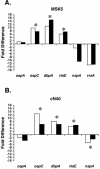Dissolved oxygen levels alter gene expression and antigen profiles in Borrelia burgdorferi
- PMID: 14977964
- PMCID: PMC356058
- DOI: 10.1128/IAI.72.3.1580-1586.2004
Dissolved oxygen levels alter gene expression and antigen profiles in Borrelia burgdorferi
Erratum in
- Infect Immun. 2004 Apr;72(4):2456
Abstract
The Lyme disease spirochete, Borrelia burgdorferi, encounters many environmental signals as it cycles between the arthropod vector and mammalian hosts, including temperature, pH, and other host factors. To test the possibility that dissolved oxygen modulates gene expression in B. burgdorferi, spirochetes were exposed to differential levels of dissolved oxygen, and distinct alterations were observed at both the transcriptional and translational levels. Specifically NapA, a Dps/Dpr homologue involved in the oxidative stress response in other bacteria, was reduced when B. burgdorferi was grown under oxygen-limiting conditions. In contrast, several immunoreactive proteins were altered when tested with infection-derived sera from different hosts. Specifically, OspC, DbpA, and VlsE were synthesized at greater levels when cells were grown in limiting oxygen, whereas VraA was reduced. The levels of oxygen in the medium did not affect OspA production. Real-time reverse transcription-PCR analysis of RNA isolated from infectious isolates of strains B31 and cN40 indicated that the expression of ospC, dbpA, and vlsE increased while napA expression decreased under dissolved-oxygen-limiting conditions, whereas flaB was not affected. The reverse transcription-PCR results corroborated the immunoblot analyses and indicated that the increase in OspC, DbpA, and VlsE was due to regulation at the transcriptional level of the genes encoding these antigens. These results indicate that dissolved oxygen modulates gene expression in B. burgdorferi and imply that the redox environment may be an additional regulatory cue that spirochetes exploit to adapt to the disparate niches that they occupy in nature.
Figures




Similar articles
-
Borrelia burgdorferi alters its gene expression and antigenic profile in response to CO2 levels.J Bacteriol. 2007 Jan;189(2):437-45. doi: 10.1128/JB.01109-06. Epub 2006 Nov 10. J Bacteriol. 2007. PMID: 17098904 Free PMC article.
-
Modification of Borrelia burgdorferi to overproduce OspA or VlsE alters its infectious behaviour.Microbiology (Reading). 2008 Nov;154(Pt 11):3420-3429. doi: 10.1099/mic.0.2008/019737-0. Microbiology (Reading). 2008. PMID: 18957595
-
Short-Chain Fatty Acids Alter Metabolic and Virulence Attributes of Borrelia burgdorferi.Infect Immun. 2018 Aug 22;86(9):e00217-18. doi: 10.1128/IAI.00217-18. Print 2018 Sep. Infect Immun. 2018. PMID: 29891543 Free PMC article.
-
Borrelia burgdorferi bba74 is expressed exclusively during tick feeding and is regulated by both arthropod- and mammalian host-specific signals.J Bacteriol. 2009 Apr;191(8):2783-94. doi: 10.1128/JB.01802-08. Epub 2009 Feb 13. J Bacteriol. 2009. PMID: 19218390 Free PMC article.
-
Transcriptional regulation of the Borrelia burgdorferi antigenically variable VlsE surface protein.J Bacteriol. 2006 Jul;188(13):4879-89. doi: 10.1128/JB.00229-06. J Bacteriol. 2006. PMID: 16788197 Free PMC article.
Cited by
-
Gene bb0318 Is Critical for the Oxidative Stress Response and Infectivity of Borrelia burgdorferi.Infect Immun. 2016 Oct 17;84(11):3141-3151. doi: 10.1128/IAI.00430-16. Print 2016 Nov. Infect Immun. 2016. PMID: 27550932 Free PMC article.
-
The RpoS Gatekeeper in Borrelia burgdorferi: An Invariant Regulatory Scheme That Promotes Spirochete Persistence in Reservoir Hosts and Niche Diversity.Front Microbiol. 2019 Aug 21;10:1923. doi: 10.3389/fmicb.2019.01923. eCollection 2019. Front Microbiol. 2019. PMID: 31507550 Free PMC article.
-
Structural determination of the complement inhibitory domain of Borrelia burgdorferi BBK32 provides insight into classical pathway complement evasion by Lyme disease spirochetes.PLoS Pathog. 2019 Mar 21;15(3):e1007659. doi: 10.1371/journal.ppat.1007659. eCollection 2019 Mar. PLoS Pathog. 2019. PMID: 30897158 Free PMC article.
-
Lyme Disease Pathogenesis.Curr Issues Mol Biol. 2021;42:473-518. doi: 10.21775/cimb.042.473. Epub 2020 Dec 23. Curr Issues Mol Biol. 2021. PMID: 33353871 Free PMC article. Review.
-
In Vivo Imaging Demonstrates That Borrelia burgdorferi ospC Is Uniquely Expressed Temporally and Spatially throughout Experimental Infection.PLoS One. 2016 Sep 9;11(9):e0162501. doi: 10.1371/journal.pone.0162501. eCollection 2016. PLoS One. 2016. PMID: 27611840 Free PMC article.
References
-
- Altuvia, S., M. Almiron, G. Huisman, R. Kolter, and G. Storz. 1994. The dps promoter is activated by OxyR during growth and by IHF and sigma S in stationary phase. Mol. Microbiol. 13:265-272. - PubMed
-
- Anguita, J., M. N. Hedrick, and E. Fikrig. 2003. Adaptation of Borrelia burgdorferi in the tick and the mammalian host. FEMS Microbiol. Rev. 27:493-504. - PubMed
Publication types
MeSH terms
Substances
Grants and funding
LinkOut - more resources
Full Text Sources
Other Literature Sources
Miscellaneous

